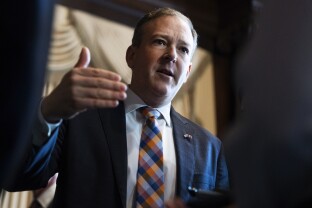The Trump administration intends to stop collecting greenhouse gas emissions data from more than 8,000 facilities across the United States — the data set that provides the most complete picture of the nation’s climate pollution.
The Environmental Protection Agency said Friday that the long-standing Greenhouse Gas Reporting Program “has no material impact on improving human health and the environment.”
The agency is issuing a proposed rule to rescind the program, which is now open for public comment.
“The Greenhouse Gas Reporting Program is nothing more than bureaucratic red tape that does nothing to improve air quality,” The EPA’s administrator, Lee Zeldin, said in the Friday press release. “Instead, it costs American businesses and manufacturing billions of dollars, driving up the cost of living, jeopardizing our nation’s prosperity and hurting American communities.”
The EPA has been collecting this data since 2010; it’s used to create a national inventory of greenhouse gas emissions and sinks, to inform the regulation of emissions and to ensure that the public has access to information on pollution.
Some research indicates the data reporting has also had some downstream impacts. A 2021 National Bureau of Economics Research paper found that power plants forced to report under GHGRP reduced their carbon emissions by about 7%, with greater reductions for publicly owned plants.
“Cutting the Greenhouse Gas Reporting Program blinds Americans to the facts about climate pollution. Without it, policymakers, businesses, and communities cannot make sound decisions about how to cut emissions and protect public health,” said Joseph Goffman, the former EPA assistant administrator for the Office of Air and Radiation.
The EPA uses the data to track the country’s effort to stop using super-polluting, high-potency greenhouse gases called hydrofluorocarbons, or HFCs, a push Congress required the EPA to facilitate in 2021 under the American Innovation and Manufacturing (AIM) Act. HFCs are used in refrigeration, air conditioning and fire suppression, and they trap thousands of times more heat in the atmosphere than carbon dioxide.
Without this reporting program, there will be no way for researchers, the public or the federal government to understand which facilities are creating greenhouse gases or how much an industry or company is producing. States that use the data to regulate climate emissions will also have to reevaluate how to do so, which is a reality the EPA acknowledged.
“The EPA understands that several states use the emissions estimation, reporting methodologies, and data from the GHGRP to develop or supplement state-level GHG emissions inventory programs,” the agency wrote.
The agency goes on to suggest that it’s difficult to quantify the costs to states of removing the program and that state governments can get the information themselves using “state authorities to support state programs.”
The EPA also acknowledged that the GHGRP has been used to track the congressionally mandated reduction of HFCs. But the agency appeared to completely dismiss the way that information is used.
“For gases regulated under the AIM Act, this information, if needed, could be collected as part of any program directly related to the AIM Act,” the agency wrote. There is no other information about the AIM act or any program related to it in the document.
As part of this proposed rescission of the program, EPA also proposed to completely stop collecting data from oil and gas companies about their greenhouse gas emissions, despite the fact that the collection of that information for the imposition of a fee was mandated by Congress in 2022.
Trump’s tax bill, signed into law in July, halted the implementation of that fee until 2034, which the EPA cites as the reason for ending reporting for those companies until that year, when the fee goes back into effect.
Sign in
Log into your free account with your email. Don’t have one?
Check your email for a one-time code.
We sent a 4-digit code to . Enter the pin to confirm your account.
New code will be available in 1:00
Let’s try this again.
We encountered an error with the passcode sent to . Please reenter your email.


